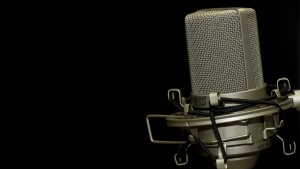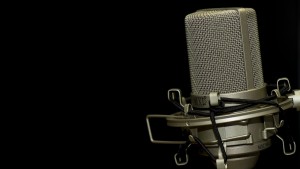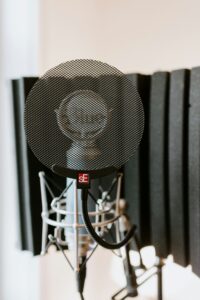 In my research to help fine-tune my own audio, I’ve learned from some of the best in the business about some great voice-over equipment and software. No matter where you are in your voice-over journey, you can find the correct voice-over equipment and software that fits within your budget and enhances your sound quality.
In my research to help fine-tune my own audio, I’ve learned from some of the best in the business about some great voice-over equipment and software. No matter where you are in your voice-over journey, you can find the correct voice-over equipment and software that fits within your budget and enhances your sound quality.
Let’s first talk about microphones. There are so many out there, but what are you looking for? The microphone is what makes you sound like you. There are some great microphones out there at all different price points, but remember, if the space you are recording in isn’t correctly sound-proofed, the audio will actually sound worse even if the microphone is one of the best. Bottom line is, if you haven’t properly treated your studio acoustics, buying a great microphone will do more harm than good so be sure to sound-proof your studio first. Some mics to consider compiled by Hugh Edwards of Gravy for the Brain:
*Sennheiser MK4: The Sennheiser MK4 is our top recommendation for any working voice-over artist. It’s a little-known fact that Sennheiser actually owns the Neumann company, and the MK4 diaphragm capsule was designed by the same team who built the Neumann U87. It’s a cardioid mic with no pad, but it sounds wonderful with both male and female voices. Compared to the other mics in this price category, this robust mic easily wins on performance and sound quality.
*Rode NT1: The Rode NT1 is a perfect voice-over mic for VO beginners. The Rode NT1 gives you a no ring resonance and similar frequency response to other voice talent microphones. It is quiet and neutral sounding, and it creates high-quality recordings with a wide dynamic range.
*Audio-Technica AT4033: The Audio-Technica AT4033 offers results in exceptional transient response and clean output signals. The AT4033 cardioid microphone has a 80Hz high-pass filter, which easily switches between flat frequency response and a low end roll-off that diminishes ambient noise and popping with close vocals.
*Neuman TLM 103: The TLM 103 is the ideal large-diaphragm microphone for anyone who wants a high quality professional mic. It functions with a transformerless circuit of the type that provides a low self-noise level and the widest dynamic range. The cardioid polar pattern capsule is particularly well-tuned for acoustic balance and good phase cancellation for sounds from the rear.
*Neumann U87: The U87 is the standard workhorse of the majority of professional recording studios in the world. It has built a reputation over time as one of the best voice recording mics on the market based upon its build quality, its performance, and its price tag. This is an exceptional microphone with a switchable polar patterns, a pad, and a flat response that works well for both female and male voices. This mic is definitely recommended if you have money to burn, but the Sennheiser MK4 is a great alternative for a tenth of the price.
When considering software, think about how you will use it and why you should choose it. When I began in this industry, I mistakenly chose to buy Pro Tools because I heard it was “the industry standard.” That’s all fine and good, but the reality was that I spent close to $1,000 on the software and training for a product that was way more complicated than what I needed. When I was forced to pay an exorbitant Pro Tools upgrade fee or find something else, I turned to George Whittam. Here’s what he said:
Pro Tools is “totally overkill for VO talent, but that is the common thought among new VO people. It is much more elaborate than necessary. I like Twisted Wave for Mac ($79), or Sony Soundforge for PC ($229), for example. When Joe (Cipriano) got started, there were very few choices for the Pros, so he got (what) was available… now there are so many more.”
I started looking around. I asked my fellow VO talent on Facebook groups what they used and why. I read on the Such A Voice website in the Members area about Audacity (which is free) under Home Studio. I took a webinar about different software choices on Voiceoverxtra led by Dan Lenard, the Home Studio Master. Adobe Audition ($19.99/mo) is a favorite among many voice-over actors. Reaper seems to be very popular for audiobook narrators. Ultimately, I chose both Audacity and Twisted Wave. I use Audacity when my neighborhood is particularly noisy or I am on the road and need to use the noise reduction feature. I use Twisted Wave for everything else – it’s especially helpful for my eLearning projects with some shortcuts for file splitting! That is why I suggested that you figure out how you are going to use the software before you purchase it.
For any other equipment you purchase, I suggest asking your friends, virtual or not, what they are using and then go to a place like Guitar Center to try the equipment out. Focus especially on your mic. Before you spend your money, speak into the mic, don’t be afraid to test it out. See if the mic enhances or subtracts from your natural sound. Hear what your headphones (or “cans,” as they are known in the studio) sound like – do you like the way they feel on your ears? Plug your mic into an interface and play around with them. See what they do! Don’t be afraid to tell the people at Guitar Center that you are just there to learn. It’s up to you whether you actually buy the product from them. You could also buy from Amazon or Sweetwater, to name a few.
No matter what you choose for yourself, you don’t have to have the best voice-over equipment and software available to produce the best audio. You DO have to have the best equipment and software that showcases YOUR voice. Know that what you begin with may not be what you end up with. I am eight years into my journey and I’m already on my third mic, third software, and I can’t even count how many sets of cans I’ve been through! For more help with your home studio, you can go to the Such A Voice website Members page under the Home Studio section. Best wishes on your voice-over journey!
Check out our VO Pro Membership for more content like this!
Jillian Nielsen is an expressive voice talent with over 14 years of experience in radio and television commercial and promotional voice-overs.
Along with the text version, we also have the audio version of this blog from the author herself and a video with some key points from the blog.





